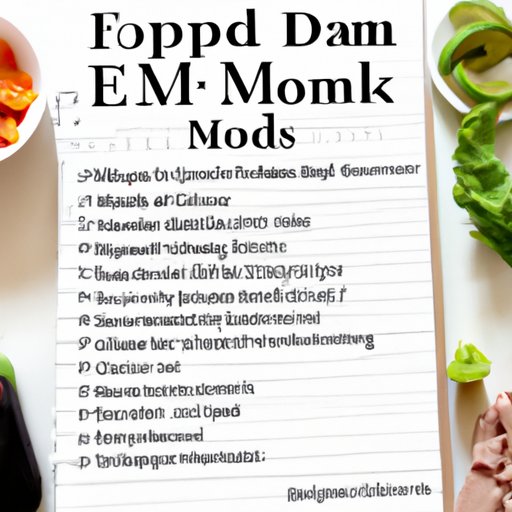Introduction
The FODMAP diet is a popular eating plan designed to help reduce symptoms of irritable bowel syndrome (IBS) and other digestive issues. The term “FODMAP” stands for Fermentable Oligosaccharides, Disaccharides, Monosaccharides, and Polyols, which are types of carbohydrates found in certain foods. This article will explore the basics of the FODMAP diet, including what foods to avoid and how to make it work for you.
What is the FODMAP Diet?
The FODMAP diet was created by researchers at Monash University in Australia as a way to help people with IBS manage their symptoms. It works by avoiding foods that contain high amounts of FODMAPs, which can be difficult to digest and trigger symptoms such as bloating, gas, abdominal pain, and diarrhea. The diet is typically followed for 6-8 weeks before reintroducing high-FODMAP foods back into your diet.
The FODMAP diet is divided into two phases: elimination and reintroduction. During the elimination phase, all high-FODMAP foods are eliminated from the diet for 6-8 weeks. This allows the gut to heal and reduces symptoms. In the reintroduction phase, high-FODMAP foods are slowly added back into the diet to determine which foods are triggers for individual symptoms.

Benefits of a FODMAP Diet
The FODMAP diet has been shown to be effective in reducing IBS symptoms. In a randomized controlled trial published in the journal Gut, researchers found that following a low-FODMAP diet reduced IBS symptoms in 73% of participants after 4 weeks. Additionally, the FODMAP diet may also help improve overall digestive health and even lead to weight loss.
“The great thing about the FODMAP diet is that it not only helps reduce IBS symptoms, but it can also improve overall digestive health,” says Dr. Roberta Anding, a registered dietitian and nutrition professor at Baylor College of Medicine. “It can also lead to weight loss since many high-FODMAP foods are high in calories.”
Foods to Avoid on the FODMAP Diet
The FODMAP diet requires avoiding certain high-FODMAP foods, such as wheat, onions, garlic, beans, dairy products, and certain fruits and vegetables. Low-FODMAP foods include gluten-free grains, lean proteins, non-dairy milks, fruits such as bananas and oranges, and vegetables such as carrots and spinach.
It’s important to note that not all high-FODMAP foods need to be avoided. Many people can still enjoy small amounts of these foods without experiencing any symptoms. It’s also important to talk to a doctor or dietitian to get an individualized plan tailored to your specific needs.

Recipes for an Easy FODMAP Diet
Following a FODMAP diet doesn’t have to be boring or complicated. There are plenty of delicious recipes that are low in FODMAPs and easy to make. Here are some ideas for breakfast, lunch, and dinner:
Breakfast: Overnight oats with almond milk, chia seeds, and fresh berries.
Lunch: Grilled chicken salad with romaine lettuce, cucumbers, tomatoes, and a vinaigrette dressing.
Dinner: Baked cod with roasted potatoes and steamed broccoli.
Tips on Making the FODMAP Diet Work for You
Making the FODMAP diet work for you requires planning and dedication. Here are some tips to help you stay on track:
- Meal Planning: Meal planning is essential for success on the FODMAP diet. Plan out your meals for the week ahead of time so you always have something healthy and low in FODMAPs ready to eat.
- Keeping Track of Symptoms: Keep a food diary to track your symptoms and reactions to different foods. This will help you identify which foods are triggers for your individual symptoms.
- Finding Support: Find a support group or online community to help you stay motivated and on track. Having someone to talk to and ask questions can make all the difference.

Common Questions About the FODMAP Diet
The FODMAP diet is a popular eating plan, but there are still some common questions about it. Here are answers to some of the most frequently asked questions:
- Is the FODMAP Diet Safe? Yes, the FODMAP diet is safe for most people. However, it’s always best to consult with a doctor or dietitian before starting any new eating plan.
- How Long Should I Stay on the FODMAP Diet? The FODMAP diet should be followed for 6-8 weeks before reintroducing high-FODMAP foods. Talk to your doctor or dietitian to determine the best timeline for you.
- Can I Still Enjoy Eating Out? Yes, it is possible to enjoy eating out while on the FODMAP diet. Look for restaurants that offer low-FODMAP options such as salads, grilled proteins, and cooked vegetables.
Conclusion
The FODMAP diet is a popular eating plan designed to help reduce symptoms of IBS and other digestive issues. It works by avoiding high-FODMAP foods and focusing on low-FODMAP alternatives. The diet can also help improve overall digestive health and even lead to weight loss. To make the FODMAP diet work for you, it’s important to plan ahead, keep track of symptoms, and find support. With the right plan and dedication, the FODMAP diet can help you achieve your health goals.
(Note: Is this article not meeting your expectations? Do you have knowledge or insights to share? Unlock new opportunities and expand your reach by joining our authors team. Click Registration to join us and share your expertise with our readers.)
